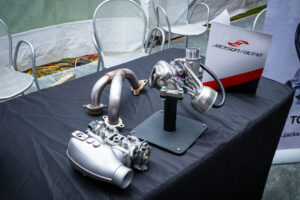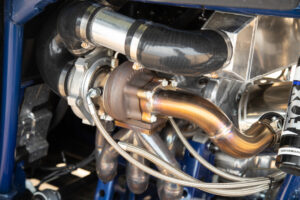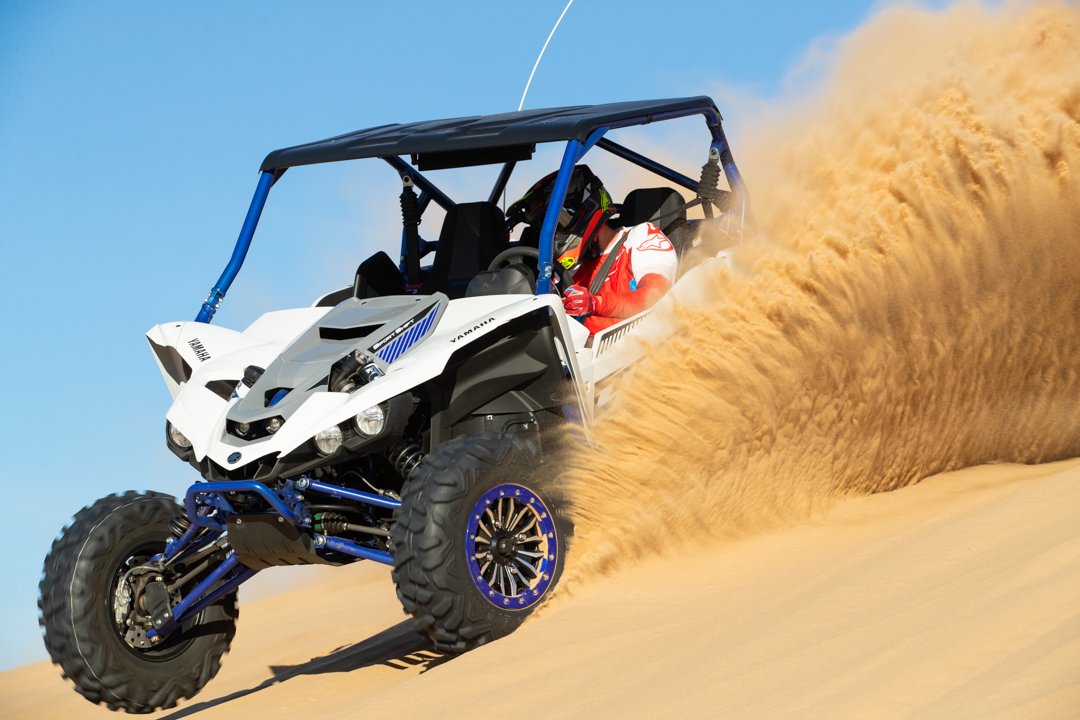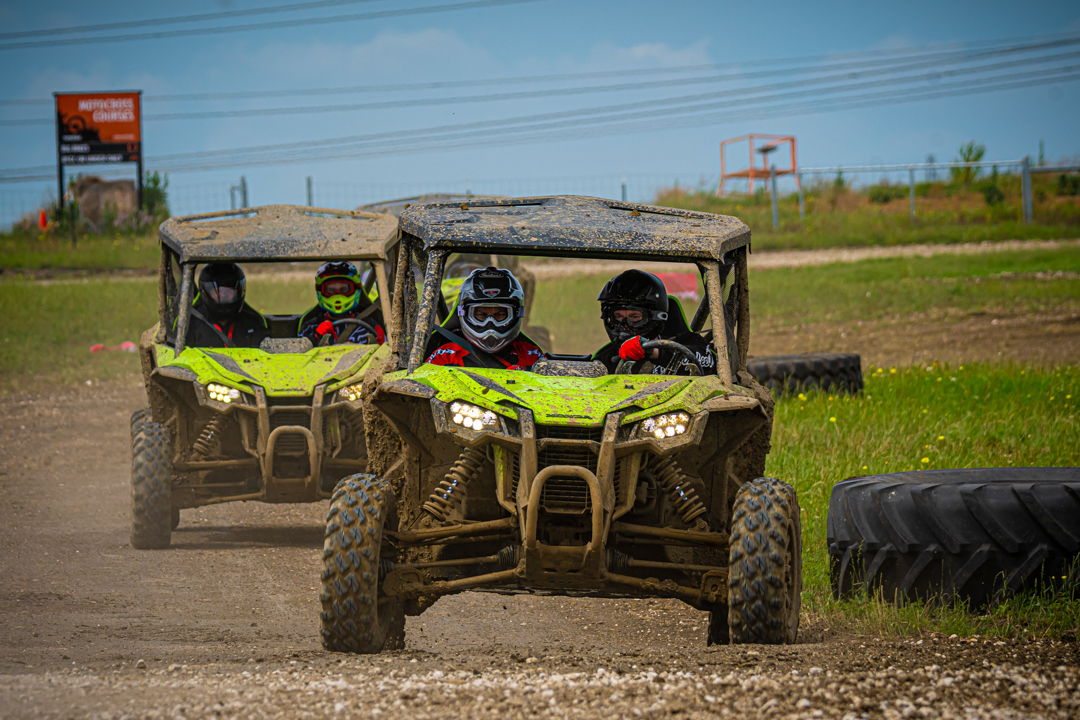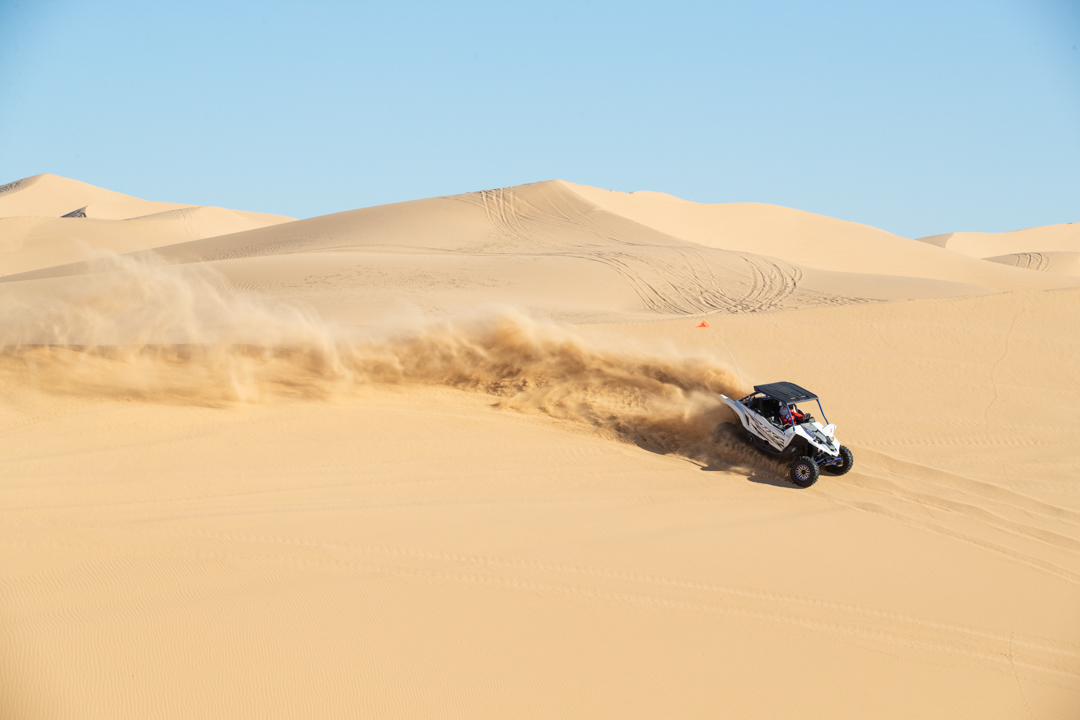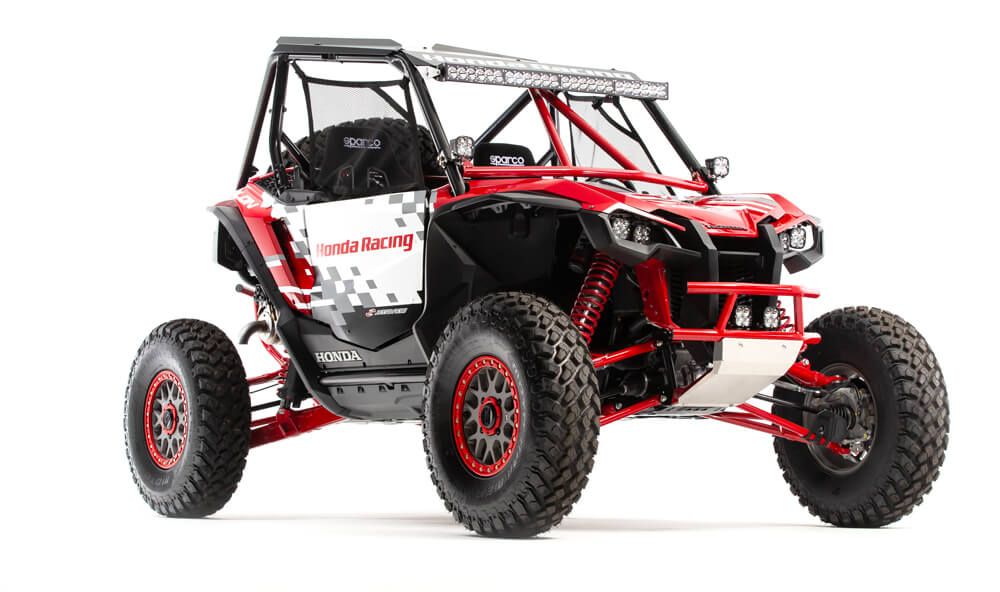Now that the Honda Talon 1000R and Yamaha YXZ1000R both have aftermarket turbo kits, we decided to give them a try. Here is our Talon 1000R Turbo vs YXZ1000R Turbo UTV Comparison. Also, did you know that both of these turbocharged UTVs will now be legal in The Mint 400 Premier Turbo UTV Class?
Story: Casey Cordeiro
Photos: Images courtesy of Yamaha (Adam Campbell Photography) and Honda Motor Corporation
Talon 1000R Turbo vs YXZ1000R Turbo UTV Comparison
If you’re like me, you like a bunch of extra go-juice under your right foot. Call it an addiction if you want, but going fast is something that I just can’t shake out of my blood. Since UTV’s are all the rage these days, my time behind a steering wheel has increased immensely – I used to be all about quad handlebars in my hands. Not a bad thing, though, because driving a UTV is an extremely fun and gratifying experience. Especially when there are Turbo’s involved…
It has been less than a year since both of the prominent Japanese UTV manufacturers have had true bolt-on Turbo kits. Shoot, it’s been less than a year since we even had a Honda Talon! When the 2019 models were unveiled, Yamaha released more than 60 upgrades to their latest and greatest YXZ1000R. Of the many upgrades to MY2019, one of the most significant had to do with the fact that the engine now included upgraded rods and internals that now gave Turbo installers the ability to simply bolt-on the GYTR Turbo system. For anyone who has a MY2019 or newer YXZ, this change will be very welcomed, making it literally a cinch to install the GYTR Turbo kit. Needless to say, the sport side-by-side industry continues to innovate at a very fast pace, and who knows where or what we’ll be talking about next year…
Back to the current time, we find that Yamaha and Honda both have very capable, very reliable, and very comfortable sport side-by-sides in their lineups. Yamaha’s YXZ1000R is the tried and true, fire-breathing, 3-cylinder UTV that has proven to be a true “driver’s car” in the naturally aspirated (N/A) sport side-by-side segment. The newcomer is the Honda Talon, which is available in a 64” wide model (1000X) and a 68” model (1000R). After seat time in both Talon models, they have proven to be driver’s cars with excellent handling characteristics in multiple terrains. Both of these Talon models also have the same basic powertrain and interior layouts, but the 1000R has a wider stance and a bit more wheel travel in the way of a 4+ link rear suspension system. For this specific article, we are going to focus on the Talon 1000R and the YXZ1000R SS SE models, which are both the Turbo-equipped models we have driven.
Yes, this article is all about the Turbo-equipped Talon and YXZ! Full disclosure, though, we haven’t pitted these two head-to-head at the same exact time. However, I have driven them both in (2) separate locations a couple months apart, and this article is going to disclose the findings that I put together after driving both. While this isn’t as good as having both together at the same time, we are excited to bring you this overview, which should allow you to draw your own conclusions as to which machine is more fitting for you. So, let’s have at it…
Talon 1000R Turbo vs YXZ1000R Turbo UTV Comparison
Since it’s the veteran UTV on the block, let’s start out with the Yamaha YXZ1000R SS SE with the factory-developed GYTR Turbo kit. I drove this vehicle out in the Glamis sand dunes this year with the crew from Yamaha. We took it on a spirited ride from the pads over to Oldsmobile hill, and then back through the big dunes. The seat time gave me plenty of experience to draw conclusions about this Turbo system, so let’s start out with the build quality.
Needless to say, the top-notch components used by Yamaha on this kit really shine through. Braided stainless steel lines are found throughout the kit, along with TIG-welded headers that just look like they are custom components. An water-to-air intercooler, which is fed by an electric water pump, is located just above the engine and keeps the turbo consistently cool. In total, the Garrett turbocharger pumps in 6psi of boost to the stock throttle bodies. Yamaha claims an output increase of up to 60%, which means that the GYTR-turbo equipped engine puts out around 184 horsepower. That’s more than almost all others in the industry, and it does so through the stock driveline components. That, my friends, means that Yamaha has complete confidence in their stock drive components. Take one look at this kit and you’ll see how well built it is compared to factory units. The beauty of this GYTR system is that it is actually made in the Yamaha factory in Georgia, sold by Yamaha, and is backed by the Yamaha R&D team. Good stuff.
If you thought Yamaha was the only manufacturer confident in their drivetrain systems, then you’d be misled in thinking that Honda doesn’t take serious pride in their stock components as well. Both companies are known for reliability and longevity, and Honda has been proving this in many different industries for many years. The build quality of the Talon speaks for itself – there are no rattles, squeaks, odd noises, clanks, or anything else, just like the YXZ. But the Honda’s methodology about putting the power to the ground is slightly different than the YXZ. Honda included a Dual Clutch Transmission (DCT) in the Talon that has 6-speeds instead of 5 in a single clutch, sequentially shifted unit like the YXZ. The Talon also has a dedicated low gear, which is made possible by a very nifty transfer case. This transfer case gives it the ability to crawl better than the YXZ in stock form (3-4 mph versus 5-6 mph). And, the Jackson Racing Turbo kit is putting out the same increase in horsepower as the GYTR kit – about a 60% increase over stock. That puts the Honda at right around 166 horsepower with the Turbo attached. So, we have about 166 horsepower in the Talon and about 184 in the YXZ1000R with Turbos attached.
Talon 1000R Turbo vs YXZ1000R Turbo UTV Comparison
Like the Yamaha, the Talon Turbo kit is all made of high quality components – it truly looks and drives like a high quality system. Installations are similar since you don’t have to tear the motors apart on either – it’s a complete bolt-on package. It all starts with the Garrett turbocharger, which is hooked up to a CAD-designed intercooler with cast aluminum end tanks with a high flow SPAL fan for maximum cooling. There is also a CAD-designed cast aluminum intake manifold that ensures accurate throttle response is maintained along with even runner distribution. The manifold is a TIG-welded 304 stainless steel unit with a strong, heavy wall design for reliability. With the stock exhaust utilized, this Honda is a total sleeper when you pull up to the start line. To finish off the Turbo system, a factory ECU reflash is provided with the Jackson Racing ECU tuning tool. This new tune optimizes all engine and transmission calibrations for proper performance dynamics on 91-octane fuel. The DCT mapping schedule is reworked for optimized feel and performance with the Turbo, too. Overall, it’s a very high quality kit – would you expect anything less?!
One of the main differences worth noting is that the Talon Turbo kit was developed with Jackson Racing and Honda engineers working together, from basically the start of Talon development many years ago. However, the Turbo kit is not coming out of the Honda factory. Instead, Jackson Racing is taking care of the manufacturing, marketing, and sales of this Turbo kit. Honda financial will allow you to wrap this kit into your financing should you be approved for the extra coin, but this is essentially a Jackson Racing kit all the way. By contrast, the GYTR Yamaha kit is an official factory accessory from Yamaha. This GYTR kit was developed by Yamaha and is purchased from the dealer or directly off of the accessory page on Yamaha’s website. Some people will say that they like the direct factory affiliation for buying an approved Turbo kit like Yamaha has. In all reality, the Honda Turbo kit was developed with the factory but is not sold by the factory. To each their own, we’re just here to give you all the details.
One of the final details worth mentioning is that the Yamaha GYTR Turbo kit retails for $5499, and Honda’s Jackson Racing Turbo Kit retails for $5799 (it starts shipping from Jackson Racing in late Fall 2019). Apples to apples for this evaluation article, the YXZ1000R SS SE retails for $20,699 MSRP. Add in the GYTR Turbo kit and your total cost (minus any fees for 2020 models) comes in at $26,198. The Honda Talon 1000R retails at $20,999, plus the Jackson Turbo kit for $5799. In total, the complete Honda Turbo Talon would run you $26,798. It’s a $600 difference, so pretty close on price point with the Yamaha just a bit lower. Granted, we also need to take into account that the Talon 1000R sits at 68.4” wide and the YXZ1000R is 64” wide. With the extra width, the Talon also has a bit more wheel travel. Those are pretty much the differences, and frankly, we all want to know how these two drive, right?! That’s the most important part…
Talon 1000R Turbo vs YXZ1000R Turbo UTV Comparison
With a bit better sightlines out the front and a more laid back seating position, the Yamaha feels more like a race vehicle from the driver’s seat. The 3-cylinder also sounds more racey from idle all the way up to 10,500+ RPM. Driving this turbocharged UTV makes the hairs on your back stand up, and it’ll make hair grow on your chest if you don’t have any. The power is felt all the way from idle to redline, and the GYTR Turbo kit builds power so smoothly that you don’t even know there is a turbo attached. This ramp up of power, which comes on very strong towards the top of the RPM range, is both exciting and addicting! It feels like the Yamaha has more power cranking out of it than “just” 184 HP. The Yamaha also has a more direct handling chassis, delivering great turn in upon entry, excellent rotation in the middle, and smooth exit. The overall steering ratio could be quickened just slightly for those of you looking to race this vehicle. I also found the stock seats lacking the lateral support that I want to have in a side-by-side, but those are two things that can be easily fixed. Other than that, the Yamaha is an absolute blast to drive.
In the glamis dunes, the GYTR Turbo kit gives a driver every kit of power you could ever want, and more. I thoroughly enjoyed being able to cruise around in 2WD (or 4WD) in the big dunes behind Olds, head to the bottom of a steep bowl with almost no momentum, and just power up the face of the steepest hill with absolute ease. Man, what a feeling grabbing gears and having no issues with how much power is on tap! After pulling a couple paddle up-shifts, I released the throttle at the top of the bowl and the engine let a satisfying blow off valve whipple sound – it’s like heaven in the sand dunes. The power is exhilarating but also extremely controllable. That’s the magic of this GYTR kit – it just makes the YXZ’s engine better in every way with more bottom end grunt, more top end whail, and a meaty mid-range that allows you to lug it through the dunes now without the need to keep this 3-cylinder in the high RPMs. Credit is due to all of the 2020 changes that make this entire vehicle come together and feel better in every way, compared to previous models. If you’re thinking of buying a YXZ1000R, it is highly recommended that you buy a 2019 or newer edition because of all of these upgraded features, and more…
Talon 1000R Turbo vs YXZ1000R Turbo UTV Comparison
Question is – can the Honda deliver the same feeling?
The short answer is “Yes!” But we have a bit more explaining to do… The stock Honda Talon 1000R is an excellent first sport side-by-side from Big Red, and it does a couple things better than the Yamaha in, again, stock trim. It crawls better with a dedicated transfer case, thus giving it a really low first gear. It also has more storage capacity in the rear cargo area, and the interior seems to be a bit better laid out for a wide range of buyers. The steering ratio also feels a bit quicker, thus making the driver work less when really pushing this vehicle to the limit.
The Honda also excels in the turbo department, where the power comes on in a very linear fashion from idle to redline. The smooth build of power is awesome and something that really takes the Talon to the next level. If you thought the Talon was lacking power from the factory – a feeling that most buyers developed – then this is the easy bolt-on solution for you. I could lug this machine out of corners and still get amazing drive onto the straightaways at the TexPlex track – the bottom end to mid range power transition is incredibly smooth, powerful, and satisfying from the driver’s seat. Or, I could pull the downshift paddle when coming into the corners, keep the revs up, and then grab gears on corner exit to enjoy an equally satisfying driving experience. This engine is so versatile that both driving styles work. At the end of the day, it was easy to determine that the Jackson Racing Turbo kit was tuned really well for all-around performance, from the low range all the way to the top end. Also, credit needs to be given to the DCT transmission here. This thing is a beautiful instrument that allows the driver to pull full throttle upshifts at redline and not even feel it, just like the sequential box in the YXZ. In all-around situations for someone who isn’t going to use their side-by-side for race applications, buyers will appreciate the Low gear feature on the Talon, and that might just be enough to get potential buyers over to the Talon. It’s like having your cake and eating it too – the Talon will perform low speed maneuvers just as well as it will pull high speed straightaways, and the Turbo kit just amplifies the feeling by a zillion. The best part about it is really the fact that the Jackson turbo kit doesn’t take away from the ease of driving a Talon. Driver’s can still just cruise around in automatic mode for a nice sunday stroll while the gears click off and you don’t have a care in the world. However, mash the gas and you have a whole LOT more go-juice under your right foot…
Yes, there a ton of positives with the Honda Turbo, but two things let the Honda down when we tried it out on the TexPlex track. First, the tires are still not a great fit for the stock vehicle. Their tendency to spin and not have forward bite doesn’t do this machine any favors, and I’d love to test the Talon Turbo out with a tire setup that bit harder and had more predictable feeling. Plus, a bit more sidewall would be very welcomed. Second, the suspension, while better on the R-model than the X-model, is still oversprung and harsh in many different situations. The Talon’s suspension is designed well and does perform in many different situations, but one these two critiques are the first two things I would “fix” if I bought a Talon. A bit lighter primary spring on the back would do wonders for this vehicle giving it a more plush ride while also taking the harsh kick out of the back. From a seat-of-the-pants feel, the Yamaha’s suspension is tuned much better from the factory with a true dual-rate setup that isn’t oversprung and is valved much better. If you like dialing in your own shocks, then the stock Fox RC2’s on all four corners of the YXZ are tailor made for you with full adjustability for compression, preload, and rebound right from the factory. The tires, paired with beadlock wheels, are also much better on the YXZ from the factory.
Talon 1000R Turbo vs YXZ1000R Turbo UTV Comparison
Overall, the Yamaha’s chassis is a bit better balanced in ways, and the YXZ remains the true “driver’s car” in this class of sport side-by-sides. The Honda is almost there in the driving dynamics department (so close!) and is a better driver than many others on the market, but it can’t quite capture the same driver excitement that the Yamaha YXZ1000R delivers time and time again. However, the dedicated low gear and ability to leave the DCT in full automatic mode make the Talon a great all-around vehicle. I also prefer the Yamaha’s radiator setup in the rear of the vehicle. This extra cooling power gives you the confidence that nothing is going to overheat, even in the harshest driving conditions with a Turbo attached.
After driving both, which would I lay down my hard earned money on? It’s a tough call, and, again, it comes down to what you’re looking for in a UTV. For me, I’m all about the ultimate driver’s car at this stage in my life, so I would go with the YXZ1000R with the GYTR Turbo kit. That doesn’t mean that the Honda Talon Turbo is a turd whatsoever – it’s still a great driver, and many people are going to love the fact that it can shift itself. The power is close on both, but the Yamaha just edges out the Honda in the fun factor.
Needless to say, both Turbo kits elevate these vehicles to all-new levels, and, at the end of the day, that’s what matters. I would absolutely recommend spending the money on either of these kits if you have the extra coin – they are SO worth it!
Until next time, be safe on the trails, and we’ll see you out there!

